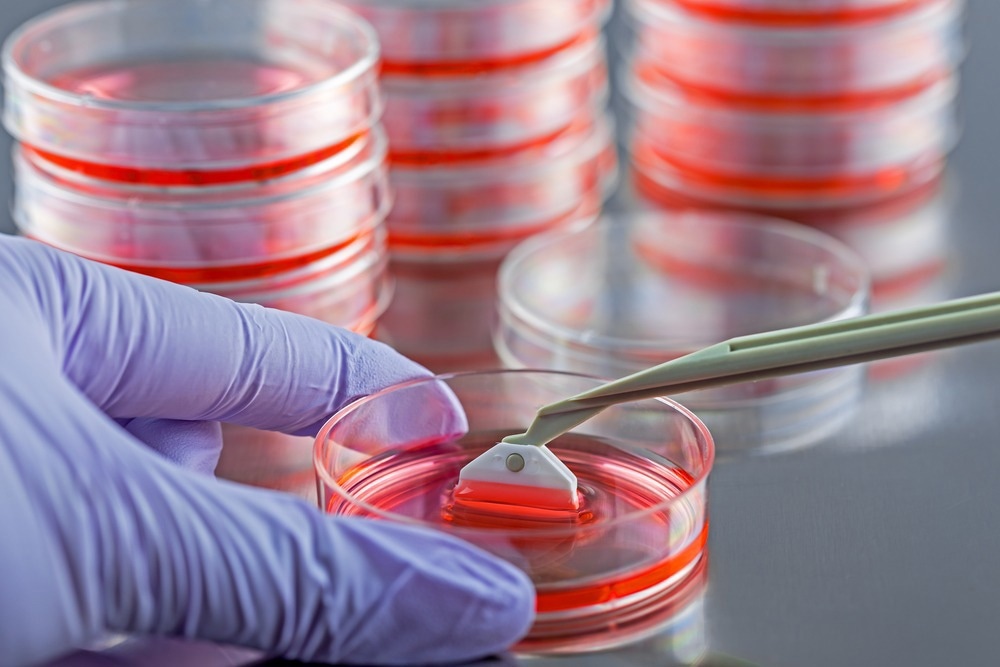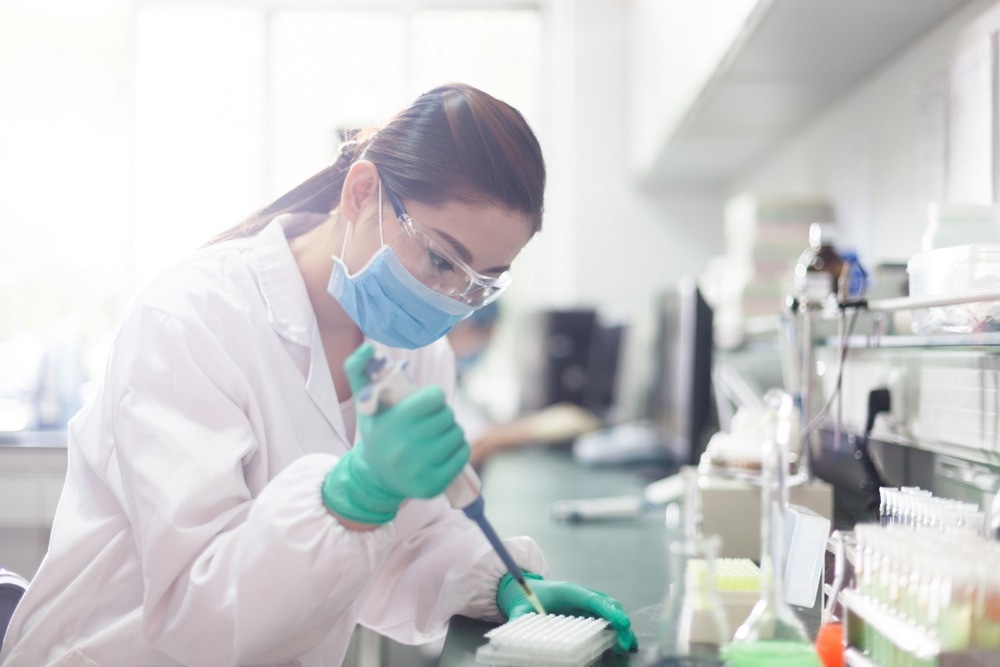Cell harvesting deals with the process of isolating specific cells from growth media. Here, we explore the latest innovations associated with harvesting different types of cells that have significant scientific implications.

Image Credit: Hakat/Shutterstock.com
Introduction to the Cell Harvesting Processes
Cell culture strategy involves the introduction of a target cell from the host population to growth media. A nutrient-rich environment allows the cell to proliferate lavishly. The targeted cells are sub-cultured, and removed from the culture media once they grow to their required stage. Cells are isolated from the culture media using different techniques, such as filtration or centrifugation. The process of isolating specific cells from growth media is known as cell harvesting.1
Although many methods are designed to harvest cells, each has some limitations. Some of the popular cell harvesting methods are discussed below.
Centrifugation
This separating method is associated with continuous spinning of the liquid culture media to separate the cells from them. Centrifugation is based on the density differences between solid cells and liquid media. Some advantages of this method are operational ease, rapid separation of cells from media, and harvesting bulk amounts in industrial settings. However, the high level of spinning increases the risk of damaging cell membranes and cell lysis, which could lead to intracellular proteins and organelles leaking into the media.2
Filtration and Microfiltration
As the name suggests, the liquid culture media containing cells are passed through a cellulose-based filter to separate cells from the broth. In the in-depth filtration method, target cells are trapped in the filter media and scientists can easily select the desired cells.3 In contrast to the centrifugation method, this is a gentler method that does not harm fragile cells.
Although the separating mechanism of microfiltration and filtration is the same, the pore size of the filter media used by the former is significantly smaller.4 Ultrafiltration technique is associated with using filter media whose pore size is one-tenth of the size of microfilters.
Other Methods
The majority of methods, such as fluorescent-activated cell separation (FACS) and magnetic-activated cell separation (MACS), used to separate immune cells (e.g., T and B cells) from unwanted substances are expensive and time-consuming. Highly trained personnel are required to operate the separative device.5
Latest Innovations in Cell Harvesting Process
A higher formulation of cell-based therapies and regenerative medicine has substantially elevated the need for innovative cell-harvesting solutions. Many recent innovations associated with adoptive cell therapy manufacturing have been documented. Many of these innovations are focused on the development of G-Rex flasks, cell culture bags, and different types of bioreactors, such as stirred-flask, hollow-fiber rocking motion, and stirred-tank.6 Some of the latest innovations in cell harvesting process are discussed below:
Bioreactors:
Bioreactors are devices that are designed to produce cells on a larger scale in a controlled environment. Many companies, such as Eppendorf and Cytiva, have developed single-use bioreactors for microbial fermentation. These fermenters use disposable bags instead of a culture vessel.7 A major advantage of single-use bioreactors is a reduction in the risk of cross-contamination, which increases the safety profile of commercially used biologics.
Automation:
Automation has substantially reduced the manual labor and tedious work required for cell harvesting. Developing an automated cell culture system could be one of the most significant achievements that enabled the production of high-quality cells in reduced time and cost. Automation in bioreactor technology helps develop pluripotent stem cells that play a crucial role in modeling human diseases and personalized cell replacement therapies.8

Image Credit: zhu difeng/Shutterstock.com
Centralized automation in the cell manufacturing process can produce high-quality products in greater quantity and at a lower cost. A highly automated cell washing system and concentration device have been recently developed in the cell manufacturing process.9 CellQualia’s intelligent cell processing system offers an automated cell manufacturing system
Several automated platforms are available for cell harvesting, which are equipped with robotic arms for liquid and labware handling. These automated labs offer sterile conditions that reduce cross-contamination risks and control cell growth environments in advanced incubators. In these incubators, the desired temperature, oxygen, and carbon dioxide levels can be maintained.
Mechanical transferring of undifferentiated pluripotent stem cells from a culture plate is a tedious task. Automation in this step has reduced the generation of unwanted cells and genetic alterations. CellCelector, manufactured by AVISO, a German company, is an automated cell harvesting device equipped with a robotic arm to select and pick specific cells for harvesting.
3D Bioprinting:
3D bioprinting technology has been used to create complex tissues and organoids.10 Recently, a modular 3D bioprinting microfluidic system has been developed that offers continuous cell harvesting in large-scale bioprocessing. This device contains two micromixers, i.e., spiral microfluidic separator and microfluidic concentrator, which can rapidly harvest mesenchymal stem cells from microcarriers. The newly developed 3D-printed modular microfluidic system supports cell harvesting without compromising cell viability and functionality.11
Monitoring System for the Enzymatic Harvesting Process
Adherent cell cultures are separated from culture vessels using an enzymatic harvesting process. Recently, a novel feature based on lens-free imaging has been added to a quantitative monitoring system to monitor the enzymatic harvesting process of adherent cell cultures. Notably, this system was validated quantitively and qualitatively using varied sets of images.12
Future Directions in Cell Harvesting
The rapid technological advancements and collaborative efforts have brightened the future of cell harvesting systems. However, more focus must be given to the quality and safety profiles of the manufactured cells, which will ultimately determine the therapeutic outcomes. Solid regulatory guidelines must be developed and followed for the same.
Many technological advancements have not only scaled up cell manufacturing but also increased the demand for the same. For instance, advanced gene editing techniques, such as CRISPR-Cas9, have enhanced the possibilities of precision therapy for many diseases. Furthermore, artificial intelligence and machine learning can be used to optimize cell growth conditions, which will ensure optimized yield and lower resource wastage.
Sources:
- Arango, M. T., et al. (2013) Cell culture and cell analysis. In: Anaya JM, Shoenfeld Y, Rojas-Villarraga A, et al., editors. Autoimmunity: From Bench to Bedside [Internet]. Bogota (Colombia): El Rosario University Press; Chapter 45.
- Stephenson, F. H. (2016) Centrifugation. Calculations for Molecular Biology and Biotechnology (Third Edition), pp. 431-438.
- Marchand, N, & Collins, M. (2023) Continuous depth filtration in perfusion cell culture. Journal of Membrane Science, 668, p. 121204.
- Charcosset, C. (2012) Microfiltration. Membrane Processes in Biotechnology and Pharmaceutics, pp. 101-141.
- Liao, X., et al. (2016) Fluorescence-activated Cell Sorting for Purification of Plasmacytoid Dendritic Cells from the Mouse Bone Marrow. Journal of Visualized Experiments, 117, p. 54641.
- Kulus, M., et al. (2023) Bioreactors, scaffolds and microcarriers and in vitro meat production-current obstacles and potential solutions. Frontiers in Nutrition, 10, p. 1225233.
- Galliher, P. M. et al. (2019) Single-Use Bioreactor Platform for Microbial Fermentation. Single‐Use Technology in Biopharmaceutical Manufacture, pp.247–258. doi.org/10.1002/9781119477891.ch21
- Doulgkeroglou, M. N., et al. (2020) Automation, Monitoring, and Standardization of Cell Product Manufacturing. Frontiers in Bioengineering and Biotechnology, 8, p. 811.
- Li, A. et al. (2021) Advances in automated cell washing and concentration. Cytotherapy, 23(9), pp. 774-786.
- Xiang, Y., et al. (2022). 3D bioprinting of complex tissues in vitro: state-of-the-art and future perspectives. Archives of Toxicology, 96(3), pp. 691-710.
- Ding, L. et al. (2022). A modular 3D printed microfluidic system: A potential solution for continuous cell harvesting in large-scale bioprocessing. Bioresources and Bioprocessing, 9(1), pp. 1-16.
- Deckers, T., et al. (2022). A novel feature for monitoring the enzymatic harvesting process of adherent cell cultures based on lens-free imaging. Scientific Reports, 12, p. 22202. doi.org/10.1038/s41598-022-22561-x
Further Reading
Last Updated: Feb 21, 2024